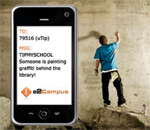
Tipping Points
A new crime-fighting tool capitalizes on the primacy of texting
- By Ronnie Rittenberry
- Nov 01, 2010
In the wake of the Virginia Tech
massacre in April 2007, and, specifically,
the critical fallout from the
university’s communication failures in
the hours following the first gunshots,
campuses across the nation were put on
alert and forced into a type of self-reflection:
What if it would have happened
here? Are we any better prepared?
Many of those who weren’t went
about trying to get that way. By 2009,
according to a survey conducted by the
National Campus Safety and Security
Project, about 58 percent of all college
and university administrators were saying
their institutions had an emergency
communication system in place. And
that percentage has since risen.
With every campus incident that has
followed -- or even natural event, such
as the so-called “Snowmageddon” in
February of this year, when a massive
snowstorm disrupted the routines of
colleges and businesses all along the
East Coast -- administrators have been
forced to ask the same questions, and
increasingly those who have found their
campuses wanting have turned to providers
to help them make sure they’re
better prepared the next time.
Today, a large majority of campuses
have at least some type of action plan,
but the sophistication of the communication
systems in place varies widely.
And variety is exactly what separates
the top-tier systems from those more
basic. The more endpoints or channels
of communication a system can reach,
the more effective it is likely to be when
a situation arises.
Channel Surfing
According to the NCSSP survey, of
those campuses that had emergency
message communication systems in
place in 2009, about 95 percent were
e-mail based. Roughly 75 percent were
text or instant-messaging based, and
about 60 percent relied on telephone
networks.
All of the above systems offer advantages
and disadvantages. As 9/11
proved in a dramatic way, cell phone
networks can be overloaded if everybody
in a region is trying to use their
phone at the same time. Text- and IM alert
systems typically require opt-in by
senders and receivers; and both e-mail and
telephone-based systems become
useless in the event of power or Internet
outages.
The beauty of a communication system
that makes use of multiple platforms
is that it’s not as vulnerable to being
made irrelevant. Such a system is based
on the idea that one can never know
what the nature of the emergency is going
to be -- nor where those who need to
receive the alerts are going to be.
That’s the modus operandi of Leesburg,
Va.-based Omnilert LLC, which
formed in 2003 and implemented its
first college emergency notification
system in 2004. Today, according to
CEO Ara Bagdasarian, more than 750
schools across the country use the company’s
e2Campus system, which makes
use of multiple communication channels --
text messages, voice phone calls,
desktop alerts, digital signage, campus
televisions, public address systems, Facebook,
Twitter, website badges, and
more -- all of which can be reached simultaneously
through one centralized,
“unified” interface.
“The whole point of a unified emergency
notification system is reaching
people through as many communication
means as possible,” Bagdasarian
said. “So, with our system, if you’re a
student and you’re on Facebook, you’ll
get the message right there. If you’re
a teacher and you’re in the classroom,
you can have the phone ring in the
classroom or have an alert appear on
your desktop system. If you’re a delivery
person walking across campus,
you might receive an audible alert from
the school’s public address system. So,
keeping it unified allows one message
to be generated and go out to multiple
communication endpoints.”
Security Can Take a Village
The latest addition to the suite of tools
included in the e2Campus system is a
feature called “uTip” that enables anyone
in a given campus or community
to communicate directly with school
representatives simply by sending an
SMS text message from their standard
cell phone. Tipsters need not be registered
with the e2Campus system for it
to work, so anyone in the surrounding
neighborhoods or town can text a tip
using the service to report suspicious
activities they see on campus, such as
theft or vandalism. Schools can set up
the service for either anonymous or
“auditable” alerts, depending on policy
guidelines or administrative choice.
“With this service, school officials
suddenly have thousands of eyes and
ears on the street, or wherever they are,
people who can report what needs reporting,”
Bagdasarian said. “Because
of its ability to be an anonymous tip
service, a student could, for example,
if he wanted to, let campus security
know that there’s a drug deal going
on in the dormitory next door, but if
he doesn’t want them to know specifically
who he is or reveal his identity,
he can submit this anonymous tip into
the school via text message as opposed
to going to an online forum or sending
in an e-mail.”
Bagdasarian added that because of
the rampancy of texting, the time is
prime for a service such as uTip. “The
reality is, if you look at behaviors of
different age demographics, those who
are 35 and under will often prefer to
send in a text message than to pick up
the phone and dial 911 or call the campus
police,” he said. “I mean, texting is
definitely much more of an accepted
behavior for that age demographic, and
obviously college students fall directly
within that age category and are constantly
texting. The bigger picture is
that we want to create safely connected
communities.”
This article originally appeared in the issue of .